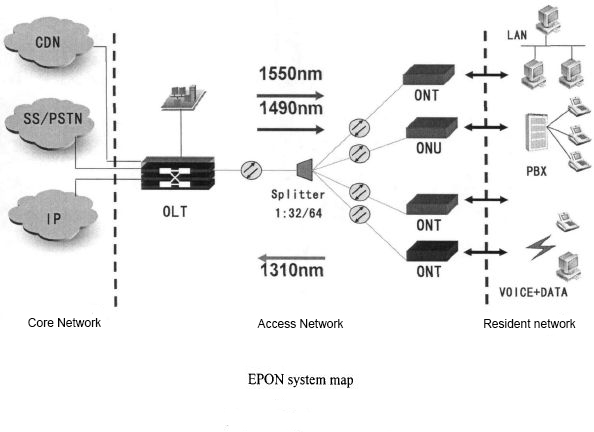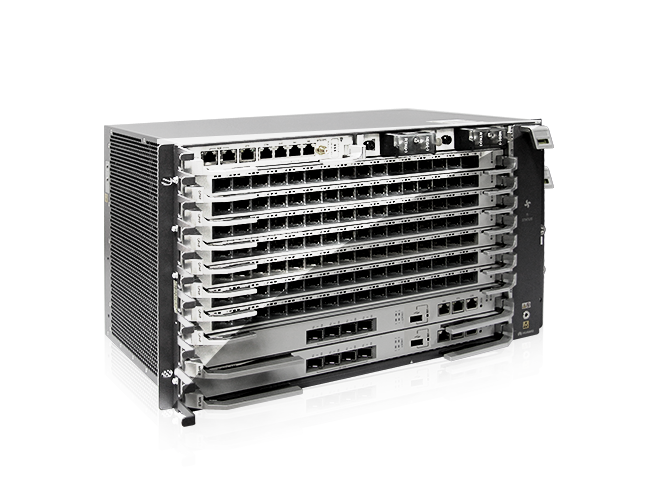What is the OLT?
An optical line termination (OLT), also called an optical line terminal, is a device which serves as the service provider endpoint of a passive optical network (From Wikipedia).
This image tells you where the OLT is in an EPON.

In short, OLT is like a commander, commanding each ONU soldier, to provide a low-cost and high-speed communication service, to connect life more closely on the planet, and technology to change life.
What is the Huawei SmartAX EA5800?
The Huawei SmartAX EA5800 Series is the full-service distributed OLT, building green, ultra-broadband, and intelligent aggregation access networks. (See all models: Huawei SmartAX EA5800 Series OLT)

Huawei SmartAX EA5800 Series provides these features:
– Provides GPON, XG-PON, XGS-PON, GE, and 10 GE access
– Supports multiple network construction modes, including POL, FTTH, FTTB, and FTTC
– Available in small, medium, and large specifications
– Up to 3.6 Tbit/s Switching Capacity of the Control Board (load sharing mode)
– Up to 100 Gbit/s Maximum Bandwidth per Service Slot (load sharing mode)
What models does the Huawei SmartAX EA5800 provide?
Huawei SmartAX EA5800 series includes 3 models, like EA5800-X17, EA5800-X7 and EA5800-X2.
This table shows the comparison of these models.
| Parameters | EA5800-X17 | EA5800-X15 | EA5800-X7 | EA5800-X2 |
| Supported Cabinets | N63E-22 | N66E-22 | N63E-22, N66E-22 | N63E-22 |
| Board Configuration | Control board slots: 9, 10 Service board or upstream interface board slots: 1 to 8, 11 to 19 Universal interface board slot: 0 Power board slots: 20, 21 | Control board slots: 8, 9 Service board or upstream interface board slots: 1 to 7, 10 to 17 Universal interface board slot: 0 Power board slots: 18, 19 | Control board slots: 8, 9 Service board or upstream interface board slots: 1 to 7 Universal interface board slot: 0 Power board slots: 10, 11 | Control board slots: 3, 4 Service board or upstream interface board slots: 1 to 2 Does not support universal interface board Power board slot: 0 |
|
Dimensions (W x D x H) | 11U high and 21 inches wide Excluding mounting brackets: 493 mm x 287 mm x 486 mm Including mounting brackets: 535 mm x 287 mm x 486 mm | 11U high and 19 inches wide Excluding mounting brackets: 442 mm x 287 mm x 486 mm Including mounting brackets: 482.6 mm x 287 mm x 486 mm | 6U high and 19 inches wide Excluding mounting brackets: 442 mm x 268.7 mm x 263.9 mm Including IEC mounting brackets: 482.6 mm x 268.7 mm x 263.9 mm Including ETSI mounting brackets: 535 mm x 268.7 mm x 263.9 mm | 2U high and 19 inches wide Excluding mounting brackets: 442 mm x 268.7 mm x 88.1 mm Including IEC mounting brackets: 482.6 mm x 268.7 mm x 88.1 mm Including ETSI mounting brackets: 535 mm x 268.7 mm x 88.1 mm |
| Maximum Weight (including mounting brackets) | 45 kg | 35 kg | 26 kg | 9.4 kg |
| Maximum Input Current | 60A | 60A | 40A | DC power supply: 20A AC power supply: 8A |
| Power Supply Modes | DC power support (dual for backup) | DC power support (dual for backup) | DC power support (dual for backup) | DC power support (dual for backup) AC power supply + battery for backup |
| Working Voltage Range | -38.4V to -72V DC | -38.4V to -72V DC | -38.4V to -72V DC | DC power supply: -38.4V to -72V AC power supply: 100V to 240V |
| Rated voltage | -48V/-60V | -48V/-60V | -48V/-60V | DC power supply: -48V/-60V AC power supply: 110V/220V |
| Ambient Temperature | -40°C to 65°C*. The EA5800 can start up at temperatures as low as -25°C. Note: The 65°C temperature refers to the highest temperature measured at the air intake vent of service subrack. | |||
| Ambient Humidity | 5% RH to 95% RH | |||
| Atmospheric Pressure | 70 kPa to 106 kPa | 70 kPa to 106 kPa | 70 kPa to 106 kPa | 70 kPa to 106 kPa |
| Altitude | 4,000m. The air density varies with altitude and will affect the heat dissipation of a device. Therefore, the working environment temperature of the EA5800 varies with altitude. | |||
| Switching Capacity of the Control Board (load sharing mode) | 3.6 Tbit/s | 3.6 Tbit/s | 3.6 Tbit/s | 480 Gbit/s |
| Maximum Bandwidth per Service Slot (load sharing mode) | 100 Gbit/s | 100 Gbit/s | 100 Gbit/s | 80 Gbit/s |
| System Layer 2 Packet Forwarding Rate (load sharing mode) | 5,298 Mpps | 5,298 Mpps | 5,298 Mpps | 714 Mpps |
| Maximum Number of Concurrent 4K Video Users | 16,000 | 16,000 | 8,000 | 2,000 |
| Maximum Number of MAC Addresses | 262,143 | 262,143 | 262,143 | 262,143 |
| Maximum Number of ARP/Routing Entries | 131,072 | 131,072 | 131,072 | 131,072 |
| Switching/Forwarding Delay | Short forwarding delay: The 100 Mbit/s Ethernet port sends 64-byte Ethernet packets at a delay shorter than 20 μs. | |||
| Bit Error Rate (BER) in full load | A BER smaller than 10e-7 for a port that transmits data in full load. | |||
| System Reliability Specifications | System availability for typical configurations: > 99.999% Mean-Time-Between-Failures (MTBF): About 45 years. Note: Due to different network environments and different boards used by devices, the preceding MTBF (45 years) of the EA5800 is only for reference. The average repair time for Field Replaceable Units (FRUs) is about 2 hours. The preceding values are only for reference. For details, please contact the relevant Huawei engineers. | |||
| GPON Ports/ XG(S)-PON Ports | 272 | 240 | 112 | 32 |
| GE/FE Ports | 816 | 720 | 336 | 96 |
| 10 GE Ports | 408 | 360 | 168 | 16 |
Does this introduction help you? Leave your comments.
Learn more:
What’s the OLT/Optical Line Terminal?




